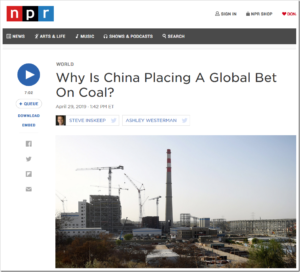by P. Homewood, June 1, 2020 in NotaLotofPeopleKnowThat
While the BBC dreams of green deals, Germany’s newest coal power station has just opened:
…
by P. Homewood, June 1, 2020 in NotaLotofPeopleKnowThat
While the BBC dreams of green deals, Germany’s newest coal power station has just opened:
…
by P. Homewood, May 10, 2020 in NotaLotofPeopleKnowThat
China approved nearly 10 gigawatts of new coal-fired power generation projects in the first quarter, roughly equal to the amount approved for all of last year, amid a broader scramble to jump-start an economy hobbled by the COVID-19 epidemic.
Investment in infrastructure like power generation has played an important part in China’s rapid economic rise, especially in times of economic distress like the global financial crisis of 2008 and 2009. Many expect such spending to play an important role as Beijing tries to restart the economy in the aftermath of the coronavirus outbreak that has brought activity to a crawl, causing the economy to post its first quarterly contraction since modern record-keeping began.
Coal has always been a controversial part of the nation’s power mix. On the one hand, China has plentiful supply of the resource, which it has harnessed to rapidly build up power infrastructure to feed the country’s growing economy. But such energy is notoriously dirty, and overly aggressive building led to oversupply earlier this decade that sent many producers into the red.
Those factors led the government to scale back and even halt many new coal-powered projects in recent years. But that trend went into reverse in the first quarter, when six major new coal-fired projects were approved that could add 9.96 GW of capacity, according to calculations by Caixin.
That was roughly equal to the amount of similar new power projects approved for all of last year. Of the new projects, four were in the coal-rich area of Shaanxi province, one was in South China’s Guangdong Province and one was in Inner Mongolia.
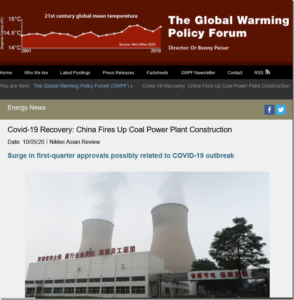
…
by Poppallov, February 24, 2020 in Electroverse
In an editorial piece published in the Investor’s Business Daily Saturday 11th February 2017, we are told about a United Nations climate report that environmentalists undoubtedly don’t want anybody to read. It states in plain English “that even if every country abides by the grand promises they made last year in Paris to reduce greenhouse gases, the planet would still be doomed…”
When President Obama hitched America to the Paris accords in 2016, he declared that it was “the moment that we finally decided to save our planet.” And when Trump pulled out of the deal this year, he was berated by legions of environmentalists for killing it.
But it turns out that the Paris accord was little more than a sham that will do nothing to “save the planet.”
According to the latest annual UN report on the “emissions gap,” the Paris agreement will provide only a third of the cuts in greenhouse gas that environmentalists claim is needed to prevent catastrophic warming. If every country involved in those accords abides by their pledges between now and 2030 — which is a dubious proposition — temperatures will still rise by 3 degrees Celsius by 2100. The goal of the Paris agreement was to keep the global temperature increase to under 2 degrees.
The measures submitted included: “Boosting renewable energy’s share to 30%. Pushing electric cars to 15% of new car sales, up from less than 1% today. Doubling mass transit use. Cutting air travel CO2 emissions by 20%. And coming up with $1 trillion for “climate action.”
Central to the report, “phasing out coal consumption … is an indispensable condition for achieving international climate change targets.” That means halting all new coal plants shutting down those currently in use.
Which is quite a big ask, as there are currently 273 gigawatts of coal capacity under construction around the world, and another 570 gigawatts in the pipeline, according to the UN. That’s a 42% increase in global energy production from coal. Which doesn’t consider the 22 coal-fired power stations to be built at 17 locations in Japan to replace their aging nuclear plants. These new installations will on their own produce more carbon dioxide annually than all the passenger cars sold in the United States each year.
So, with all the hype in the media about “climate change” and with NOAA admitting to data manipulation, as well as acknowledging that the climate has been cooling for the past 10 years, when is the UN going to shut-up shop and call an end to this panhandling charade?
by P. Gosselin, February 22, 2020 in NoTricksZone
The German government recently decided to exit from coal generated power by 2038, and now one expert says that the exit is going to cost handsomely, and bring zero result. Still, that 2038 target is too slow for some.
That’s how German politicians make decisions on things that concern the economy and environment. The German government’s aim of a coal phaseout is to contribute to protecting the climate. In reality, it will have no impact at all.
German online FOCUS magazine reports here: “80 billion euros are to be given to the affected regions and companies in the coming years as aid and compensation.”
But for some experts, the 2018 target date for completing the coal exit is too late, and thus risks seeing Germany emitting another 140 million tonnes of extra CO2 between 2020 and 2040 by exiting so slowly, so claims the German Institute for Economic Research (DIW).
To keep that 140 million ton figure in a global perspective, it is barely a drop in the bucket when compared to the 33 billion tonnes emitted globally and annually. The climate is not even going to notice it.
by Hiroko Tabuchi, February 5, 2020 in TheNewYorkTimes
It is one unintended consequence of the Fukushima nuclear disaster almost a decade ago, which forced Japan to all but close its nuclear power program. Japan now plans to build as many as 22 new coal-burning power plants — one of the dirtiest sources of electricity — at 17 different sites in the next five years, just at a time when the world needs to slash carbon dioxide emissions to fight global warming.
…
by P. Homewood, January 28, 2020 in NotaLotofPeopleKnowThat
Provisional figures from the China Energy Portal indicate that thermal generation continues to rise in China, albeit at a slower rate then the last few years

https://chinaenergyportal.org/en/2019-electricity-other-energy-statistics-preliminary/
As I noted in November, there are three factors behind the slower rise in thermal (which is almost certainly predominantly coal-fired):
- Overall demand for electricity has increased at a much slower rate in 2019 – 4.7% against 8.4% in 2019. This reflects the dramatic slowdown in Chinese economic growth.
- New nuclear capacity has been added in the last two years.
- Better hydro generation, presumably due to wetter weather.
Significantly, thermal generating capacity has continued to grow in 2019, by 4.1%. Just as significant is the dramatic slowdown in new solar power capacity being added. In 2018, 45GW was added, but this dropped to 26GW last year, following the restriction of subsidies.
New wind capacity increased marginally in 2019, from 21GW in 2018 to 25GW.
Also China’s Coal Power To Remain Dominant Till At Least 2035
by K. Richard, December 19, 2019 in NoTricksZone
Today, 30% of the globe’s CO2 emissions come from China. In 10 years, China’s emissions alone will match the rest of world’s emissions combined. China continues to build hundreds of coal plants today. So why are the rest of us spending $600 billion every year on CO2 emissions mitigation?
China overtook the United States as the world’s largest CO2 emitter in 2008 (Liu et al., 2019).
…
by P. Homewood, December 17, 2019 in NotaLotofPeopleKnowThat
Coal consumption is set to rise in the coming years as growing demand for electricity in developing countries outpaces a shift to cleaner sources of electricity in industrialised nations.
While use of the most polluting fossil fuel had a historic dip in 2019, the International Energy Agency anticipates steady increases in the next five years. That means the world will face a significant challenge in meeting pledges to reduce greenhouse gas emissions that cause global warming.
Annual coal report
“There are few signs of change,” the agency wrote in its annual coal report released in Paris on Tuesday. “Despite all the policy changes and announcements, our forecast is very similar to those we have made over the past few years.”
While this year is on track for biggest decline ever for coal power, that is mostly due to high growth in hydroelectricity and relatively low electricity demand in India and China, said Carlos Fernandez Alvarez, senior energy analyst at the Paris-based IEA.
Despite the drop, global coal consumption is likely to rise over the coming years, driven by demand in India, China and Southeast Asia. Power generation from coal rose almost 2% in 2018 to reach an all-time high, remaining the world’s largest source of electricity.
…

by The Japan Times, December 2, 2019
WASHINGTON – As world leaders gather in Spain to discuss how to slow the warming of the planet, a spotlight falls on China — the top emitter of greenhouse gases.
China burns about half the coal used globally each year. Between 2000 and 2018, its annual carbon emissions nearly tripled, and it now accounts for about 30 percent of the world’s total. Yet it’s also the leading market for solar panels, wind turbines and electric vehicles, and it manufactures about two-thirds of solar cells installed worldwide.
“We are witnessing many contradictions in China’s energy development,” said Kevin Tu, a Beijing-based fellow with the Center on Global Energy Policy at Columbia University. “It’s the largest coal market and the largest clean energy market in the world.”
That apparent paradox is possible because of the sheer scale of China’s energy demands.
But as China’s economy slows to the lowest level in a quarter century — around 6 percent growth, according to government statistics — policymakers are doubling down on support for coal and other heavy industries, the traditional backbones of China’s energy system and economy. At the same time, the country is reducing subsidies for renewable energy.
…
…
by P. Homewood, December 1, 2019 in NotaLotofPeopleKnowThat
China has signalled that coal power will be a top priority within national energy policy as the government prepares its next Five Year Plan (2021-25).
On 11 October, Premier Li Keqiang chaired a meeting of the National Energy Commission in Beijing that emphasised China’s energy security and coal utilisation and downplayed the importance of a rapid transition away from fossil fuels.
Each meeting of the commission, which was established in 2010 and has met only four times, has had a significant impact on policymaking. Chaired by Premier Li and attended by more than 20 chiefs of China’s ministries and bureaus, the commission is the top body for coordinating energy policy.
Why is energy security back at the top of the agenda?
Li told the conference: “The government should diversify energy supply to improve energy security… enhance domestic oil and gas exploration and development efforts, and promote oil and gas reserves and production, in order to improve oil and gas self-sufficiency”.
The renewed focus on energy security comes amid an increase in domestic consumption of oil and gas, which is largely being met through imports. China’s dependence on energy imports rose from 9% in 2014 to more than 20% in 2018.
China’s domestic crude oil production has declined and efforts to tap unconventional sources of natural gas, such as shale gas and coalbed methane, have faltered.
Other causes for concern lie outside China. The ongoing trade dispute with the US is a threat to the energy trade between the two superpowers, and supplies from the Middle East are at risk from mounting instability in the region.
…

by Bloomberg News, November 20, 2019
China has enough coal-fired power plants in the pipeline to match the entire capacity of the European Union, driving the expansion in global coal power and confounding the movement against the polluting fossil fuel, according to a report.
The nation has almost 148 gigawatts of coal-fired capacity under active construction or likely to be resumed after being suspended, Global Energy Monitor, a non-profit group that tracks coal stations, said in the report Thursday based on plant-by-plant data. That’s almost equivalent to 150 gigawatts of existing coal fleet capacity in the EU and more than the combined 105 gigawatts under construction in the rest of the world, it said.
In contrast to many other countries, including the U.K.’s pledge to shut all coal plants by 2025, Beijing remains committed to coal as its biggest source of power, representing a major challenge to global emissions reduction targets. Its additions in the 18 months to June dwarf declines elsewhere in the world, according to the report.
…
by Charles the moderator, November 1, 2019 in WUWT
There’s just no stopping coal in Southeast Asia. Surging investments in wind and solar energy won’t be enough to shake the fuel’s dominance in the region for decades to come, according to the International Energy Agency.
Coal demand is expected to double to almost 400 million tons a year by 2040, the agency said in its Southeast Asia Energy Outlook published Wednesday. That’s 2.5% higher than its forecast from two years ago, even as renewable power capacity is seen more than tripling through 2040.
“Coal is rather resistant because it is affordable,” said Keisuke Sadamori, IEA’s director for energy markets and security. “It’s really hard for Southeast Asian countries to move away from affordable coal immediately.”
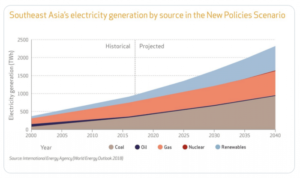
…
by Amy Hawkins, October 22, 2019 in The Times
China is expanding its coal power infrastructure despite pledges to curb carbon emissions.
Analysis reveals that the amount allocated to large infrastructure projects by Beijing has doubled this year, with airports and high-speed rail lines among 21 schemes allocated a total of £83.9 billion.
Included in the new allocations is funding for 17 new coal mines across China, despite Beijing’s pledges to reduce reliance on the power source.
Seven mines were approved last year and, between 2017 and 2018, China added 194 million tonnes of coal mining capacity with the total number of mines reaching more than 3,000.
China, the world’s biggest coal consumer, has vowed to cap carbon emissions by 2030, although it has stopped short of the “net zero” emissions target by 2050…
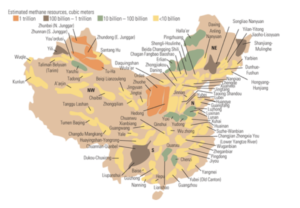
China’s coal basins and coalbed methane resources. Source: Caterpillar Inc.

China consumes more coal than all other nations together
by David Middleton, October 4, 2019 in WUWT
‘Coal is still king’ in Southeast Asia even as countries work toward cleaner energy
PUBLISHED MON, SEP 30 2019
Huileng TanKEY POINTS
• Not only will coal continue to be the dominant fuel source in power generation in Southeast Asia, its use will grow and peak in 2027 before slowing, according to a Wood Mackenzie study.
• The Indonesian government has targeted generating 23% of electricity from renewable sources by 2025 — almost double the 12% now, but it will be “difficult to achieve because capacity expansion plans are still dominated by coal,” Moody’s analysts say.
• Global coal demand grew for a second straight year to reach 0.7% in 2018, International Energy Agency data shows.
Coal is still a dominant fuel in the rapidly growing economies of Southeast Asia, even amid a general global move toward cleaner energy sources, data from several recent reports show.
…
…
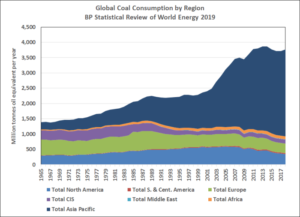
Figure 1. Global coal consumption by region (million tonnes of oil equivalent per year). BP Statistical Review of World Energy 2019.
…
by Reuters, Sep. 19, 2019
SHANGHAI (REUTERS) – China’s total planned coal-fired power projects now stand at 226.2 gigawatts (GW), the highest in the world and more than twice the amount of new capacity on the books in India, according to data published by environmental groups on Thursday (Sept 19).
The projects approved by China amount to nearly 40 per cent of the world’s total planned coal-fired power plants, according to the Global Coal Exit List database run by German environmental organisation Urgewald and 30 other partner organisations.
The new China projects would be more than Germany’s existing installed power capacity of around 200 GW by the end of 2018.
The environmental groups said in a press release on Thursday that worldwide 400 of the 746 companies in their database were still planning to expand their coal operations.
The companies include miners and power generators, and account for 89 per cent of the world’s thermal coal production and nearly 87 per cent of the world’s installed coal-fired power capacity. Of the total, 161 are Chinese.
…
by Reuters, August 6, 2019 in GWPF
SHANGHAI/BEIJING (Reuters) – Approvals for new coal mine construction in China have surged in 2019, government documents showed, with Beijing expecting consumption of the commodity to rise in the coming years even as it steps up its fight against smog and greenhouse gas emissions.

Long-term cuts in coal consumption are a key part of China’s energy, environment and climate goals, but the fivefold increase in new mine approvals in the first-half of 2019 suggests China’s targets still provide ample room for shorter-term growth.
China’s energy regulator gave the go-ahead to build 141 million tonnes of new annual coal production capacity from January to June, compared to 25 million tonnes over the whole of last year, Reuters analysis of approval documents showed.
The projects included new mines in the regions of Inner Mongolia, Xinjiang, Shanxi and Shaanxi that are part of a national strategy to consolidate output at dedicated coal production “bases”, as well as expansions of existing collieries, the National Energy Administration (NEA) documents showed. […] Chinese coal output rose 2.6% in the first-half of 2019 to 1.76 billion tonnes.
MORE TO COME?
Industry groups still expect coal-fired power capacity to increase over the next few years, with investments in nuclear and renewables still insufficient to cover rising energy demand.
The research unit of the China State Grid Corporation last month forecast that total coal-fired capacity would peak at 1,230-1,350 gigawatts (GW), which would mean an increase of about 200-300 GW.
A study published earlier this year also suggested China’s targets would allow the construction of another 290 GW of coal-fired capacity in the coming years.
…
by GWPF, August 5,2019 in EnergyLiveNews
That’s according to the Chief Engineer at the country’s Federal Power Ministry, Ghanshyam Prasad, who Reuters reported as stating coal capacity is likely to reach 238GW by 2022.
India’s Coal Minister, Pralhad Joshi previously said annual coal demand rose by 9.1% during the year ending March 2019, noting the figure hit 991.35 million tonnes, driven primarily by utilities, which accounted for three-quarters of total demand.
The anticipated growth is likely to affect efforts to cut emissions and could risk worsening already poor air quality.
India’s electricity demand rose by 36% in the seven years up to April 2019, while coal-fired generation capacity during the period rose by three-quarters to 194.44GW.
Pralhad Joshi said despite the growth rate in thermal capacity outpacing electricity consumption in the last few years, more coal-fired plants will still be needed in the future to meet growth.
He added: “If we have to meet demand and address the intermittencies we have with solar and wind, we have no choice but to keep depending on coal-based generation in the near future.”
by P. Homewood, July 23, 2019 in NotaLotofPeoppleKnowThat
SANHE, China (Reuters) – China Energy Group, the country’s biggest power generator, will add more than 6 gigawatts (GW) of new ultra-low emission coal-fired capacity this year as it bids to meet growing electricity demand, a senior official with the firm said on Thursday.
The company also expected to build another 5 GW of low-emission capacity next year, Xiao Jianying, the head of the state-run firm’s coal-fired power department, told Reuters.
“China still has quite a big demand for electricity. The government now supports regions with poor wind and solar resources to use coal-fired power … it’s a more practical measure, as gas is still too expensive,” said Xiao.
China Energy operated coal-fired plants with a total capacity of 175 GW at the end of 2018, 77.4% of its total capacity and about 10% of the entire country’s capacity.
…
by Reuters, July 23, 2019 in WUWT
SANHE, China (Reuters) – China Energy Group, the country’s biggest power generator, will add more than 6 gigawatts (GW) of new ultra-low emission coal-fired capacity this year as it bids to meet growing electricity demand, a senior official with the firm said on Thursday.
The company also expected to build another 5 GW of low-emission capacity next year, Xiao Jianying, the head of the state-run firm’s coal-fired power department, told Reuters.
“China still has quite a big demand for electricity. The government now supports regions with poor wind and solar resources to use coal-fired power … it’s a more practical measure, as gas is still too expensive,” said Xiao.
China Energy operated coal-fired plants with a total capacity of 175 GW at the end of 2018, 77.4% of its total capacity and about 10% of the entire country’s capacity.
Xiao said the company would gradually shut down small and polluting coal-fired power units and replace them with efficient ones, noting that total capacity would continue to increase but at a slower rate of growth.
The firm is also planning to launch another carbon capture and storage (CCS) project in northwest China next year as part of its efforts to reduce the environmental impact of using coal, company officials said. It already runs a CCS plant at its coal-to-oil facility in Erdos in Inner Mongolia.
China, the world’s biggest greenhouse gas emitter, has vowed to control new coal production and new coal-fired power capacity as part of its commitments to curb pollution and tackle global warming. However, it has shown signs of relaxing restrictions in recent months amid an economic slowdown.
…
by Graham Hill, June 13, 2019 in GWPF/TheAustralian
Global coal production (up 4.3 per cent) and consumption (up 1.4 per cent) has increased at their fastest rate for five years.
Average global greenhouse gas emissions are rising at double the rate of Australia’s, exposing the mismatch between the “hope and reality” of meeting Paris Agreement goals, a report has found.
A major report by energy giant BP said the world was returning to coal, and without shale gas from the US and LNG exports from Australia the emissions reduction picture would be much worse.
Massive investments in renewable energy were needed but would not be enough to satisfy increasing demands for power, most notably in China and India.
BP said global emissions overall were up 2 per cent last year as the unexpected return to coal gathered pace.
…
by Tilak Doshi, June 7, 2019 in Forbes
The reigning narrative of impending global environmental catastrophe dominates the airwaves and print media. Short of a drastic reduction in the use of fossil fuels, it is asserted, we are fast approaching the “end of days”. The demonization of fossils fuels in general, and coal in particular, has been wrought under pressure from special interests groups and organized lobbies of the climate-industrial complex where aspects of economic reality are caricatured or presented out of context. Complex trade-offs in energy policy are spun into tales of spurious simplicity, leading to misleading conclusions. Nowhere is this more apparent than in the debate over the role of coal-fueled power generation in Asia.
Opposition to the building of coal power plants in the poorer countries has been justified by environmental activists, banks and multilateral development agencies such as the World Bank in two key ways. The first revolves around the claim that climate change mitigation programs carry “co-benefits” for public health in developing countries. The second utilizes the assertion that renewable energy such as solar and wind power are effective substitutes for centralized grid electricity generated by fossil fuels.
Climate change policy does not help the poor
…
by Energy World, May 22, 2019
New Delhi: Fitch Solutions Tuesday said India’s thermal coal output is projected to grow at an average annual rate of 4.3 per cent by 2028. “In absolute volume terms, China and India will have the largest impact on the global coal market balance,” Fitch Solutions Macro Research said in a report.
It further said the surge in Chinese imports that occurred over 2015-2017 as a result of dramatic domestic production curbs was a temporary phenomenon.
“We forecast thermal coal production in China to stagnate at 0.5 per cent growth per annum from 2019 onwards, but not decline, as new coal mines in Inner Mongolia, Shaanxi and Shanxi provinces offset mine closures in the rest of the country,” it said.
…
by Charles the moderator, May 24, 2019 in WUWT
Climate change was supposed to have won the party the Australian election. But yesterday, routed in the polls, panicking Labor Party leaders backed the opening of a coal field bigger than the UK to mining.
Fearing a wipeout in state elections next year amid a rising tide of pro-coal workers and a rebellion against its plans to halve Australia’s carbon emissions, the Labor state government in Queensland accelerated its decision on 105,000 square miles of coal-rich outback land known as the Galilee Basin.
It came days after the party lost what was dubbed as the “climate election” to the incumbent centre-right, pro-coal government of Scott Morrison, suffering the most damage with swings of up to 20 per cent in the coal country of central Queensland and the Hunter Valley of New South Wales.
Queensland’s premier, Annastacia Palaszczuk, announced she was overturning all attempts to block mining and all outstanding approvals would be resolved within three weeks. She said she was “fed up” with her own government’s processes, and that the election had been a “wake-up call” on mining the basin. The move was welcomed by the federal resources minister, Matt Canavan, who told The Times yesterday that the Galilee Basin represented a victory for the “hi-vis workers’ revolution” — a reference to the armies of mine workers, dressed in high-visibility shirts, who make Australia the world’s biggest coal exporter, and seemingly a reference to the “yellow vest” movement in France which battled President Macron on his climate policies.
…
by P. Homewood, May 18, 2019 in NotalotofPeopleKnowThat
While western politicians are declaring climate emergencies, India has continued to expand its coal power.
During the financial year just ended, thermal generation increased by 3.37%, accounting for most of the increase in total generation:
…
by P. Homewood, April 30, 2019 in NotaLotofPeopleKnowThat
China is building 300 new coal power stations around the world, according to NPR(National Public Radio), who I gather are the US equivalent of the BBC.
China, known as the world’s biggest polluter, has been taking dramatic steps to clean up and fight climate change.
So why is it also building hundreds of coal-fired power plants in other countries?
President Xi Jinping hosted the Belt and Road Forum in Beijing over the weekend, promoting his signature foreign policy of building massive infrastructure and trade links across several continents.
The forum, attended by leaders and delegates of nearly 40 countries, came amid growing criticism of China’s projects, including their effect on the environment.
Xi took the highly unusual step, for him, of meeting with international journalists, during which he repeated the slogan that he is committed to “open, clean and green development.”
…
